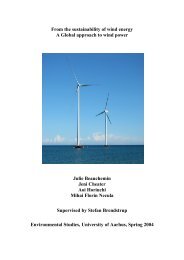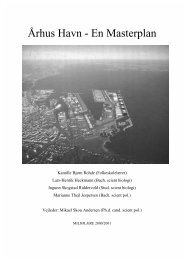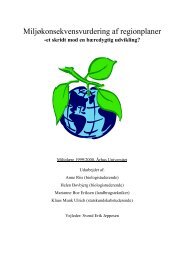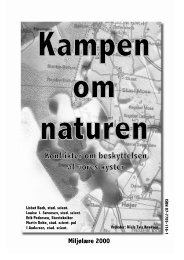University of Aarhus ECOTOURISM AS A WAY TO PROTECT ...
University of Aarhus ECOTOURISM AS A WAY TO PROTECT ...
University of Aarhus ECOTOURISM AS A WAY TO PROTECT ...
Create successful ePaper yourself
Turn your PDF publications into a flip-book with our unique Google optimized e-Paper software.
Ecotourism as a sustainable way to protect nature<br />
Generating benefits from ecotourism have been discussed in different<br />
dimensions. It could be a means <strong>of</strong> generating economic benefits for different<br />
stakeholders, increasing awareness for both local communities and tourists,<br />
promoting biodiversity conservation and mitigating negative impacts.<br />
2.6.1. Generating economic benefits for different stakeholders<br />
Ecotourism not only generates economic benefits for government<br />
agencies, non-government agencies but also for local people.<br />
First <strong>of</strong> all, all forms <strong>of</strong> tourism have greatly contributed to the national<br />
and international economy. This point <strong>of</strong> view has been mentioned before.<br />
Especially, this economic source is very important for developing countries.<br />
Thailand earned approximately US$1.5 million a year for set <strong>of</strong> parks (FAO,<br />
1997). Nepal has received total revenue <strong>of</strong> US$4.5 million in 1994 just from the<br />
hotel industry in the Royal Chitwan National Park (Marnie et al., 1998).<br />
Globally, all tourism in the developing countries earned about US$ 118,518<br />
million in 1995 (Stefan, 1999).<br />
Secondly, entrance fees can significantly contribute to the cost <strong>of</strong><br />
managing the national parks. The fees account for 0.01 to 1% <strong>of</strong> the total travel<br />
costs (Stefan, 1999). Here, we would like to illustrate just how large the entrance<br />
fees are. The Monteverde Cloud Forest Reserve earned US$ 35,750 in 1987,<br />
Costa Rica got approximately US$ 168,000 in 1988 while Ecuador received<br />
US$ 2.6 million in 1993 (Stefan, 1999) and US$ 4.3 million in 1998 (UNEP,<br />
2002). The New Special laws <strong>of</strong> Tourism in Galapagos Island requires to put<br />
40% entrance fees for the protected area (Honey, 1999). These incomes are<br />
expected to cover a range <strong>of</strong> conservation-related expenditures (Stefan, 1999). In<br />
contrast, the case <strong>of</strong> tourism in Indonesia (Sheryl & Wall, 1999), all entrance<br />
fees were sent to the central government without filtering back to the protected<br />
areas.<br />
29
















